BUECO5903 Business Economics: Macroeconomics, Unemployment & GDP
VerifiedAdded on 2022/08/17
|7
|1109
|13
Homework Assignment
AI Summary
This assignment explores key macroeconomic concepts through a series of questions. It begins by analyzing different types of unemployment in Estralia, including seasonal, structural, and cyclical unemployment, differentiating them based on their causes and impact. The assignment then examines the impact of a decrease in money supply on aggregate and investment demand, highlighting the inverse relationship between interest rates and investment, and the subsequent effects on real GDP and inflation. Furthermore, it discusses below full employment equilibrium, illustrating the concept of a recessionary gap and the impact of a negative supply shock. Finally, the assignment addresses the implications of a current account deficit, its short-term benefits, and long-term constraints on economic policies, emphasizing the importance of current account surplus for economic vitality. Desklib offers a wealth of similar solved assignments and past papers to aid students in their studies.
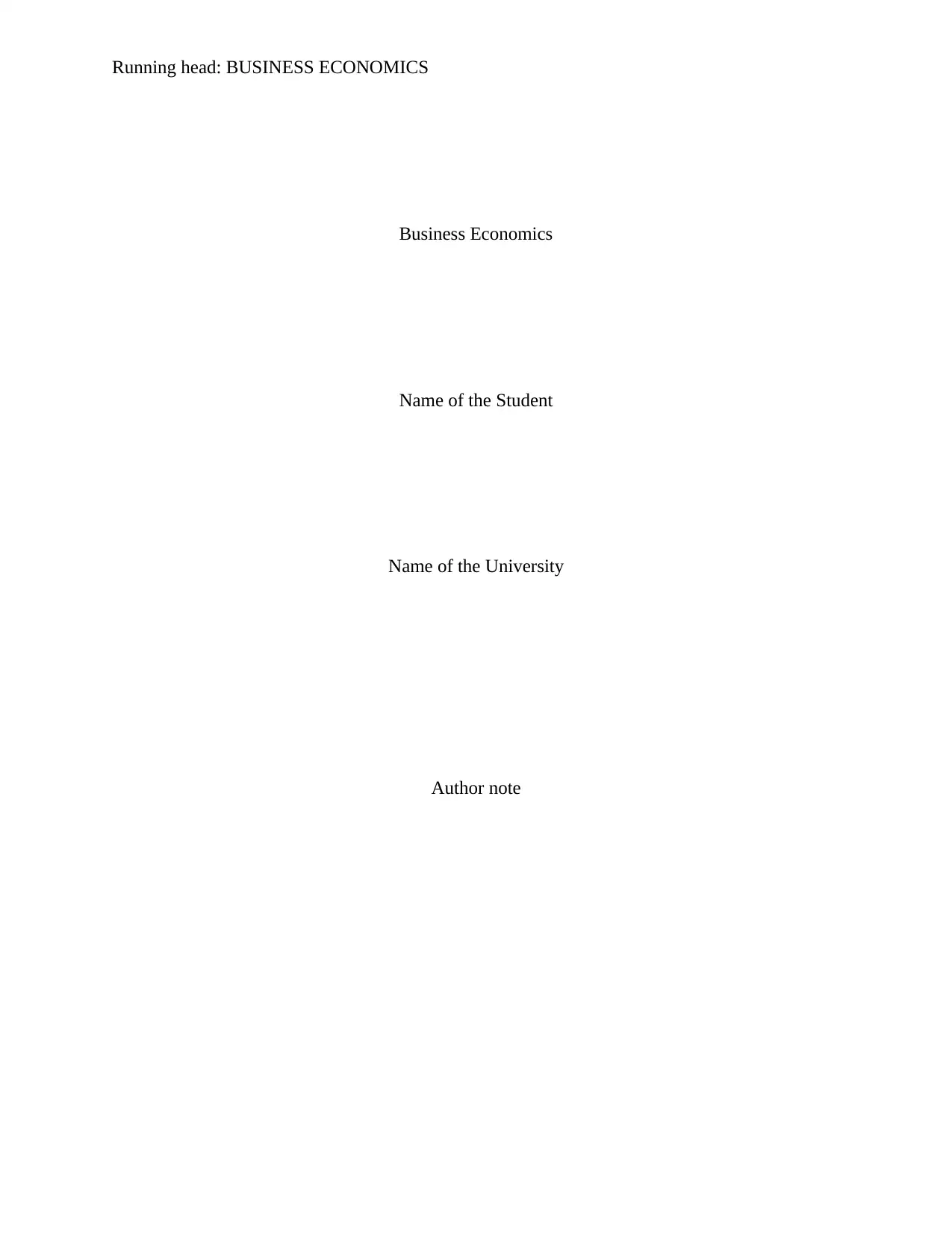
Running head: BUSINESS ECONOMICS
Business Economics
Name of the Student
Name of the University
Author note
Business Economics
Name of the Student
Name of the University
Author note
Paraphrase This Document
Need a fresh take? Get an instant paraphrase of this document with our AI Paraphraser
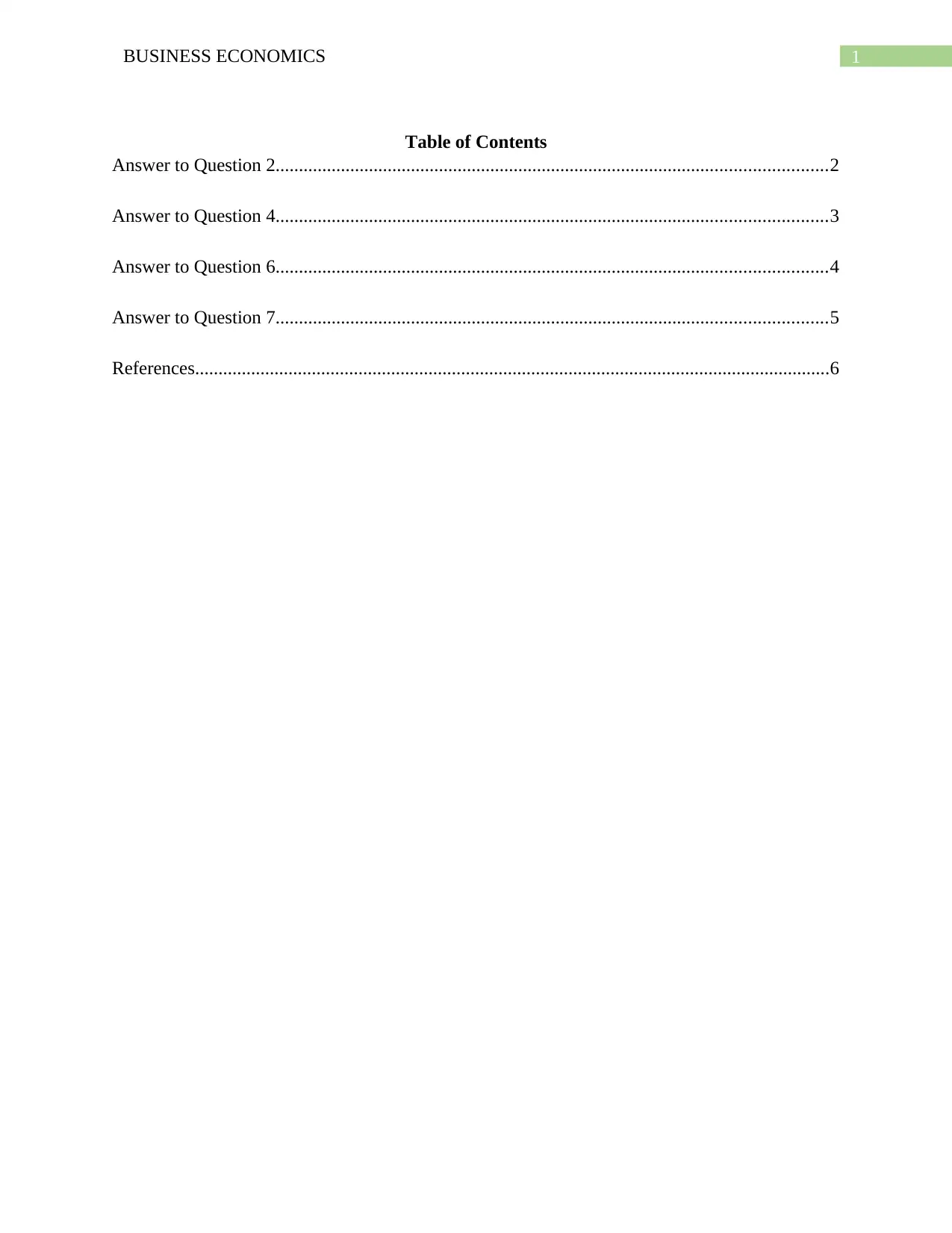
1BUSINESS ECONOMICS
Table of Contents
Answer to Question 2......................................................................................................................2
Answer to Question 4......................................................................................................................3
Answer to Question 6......................................................................................................................4
Answer to Question 7......................................................................................................................5
References........................................................................................................................................6
Table of Contents
Answer to Question 2......................................................................................................................2
Answer to Question 4......................................................................................................................3
Answer to Question 6......................................................................................................................4
Answer to Question 7......................................................................................................................5
References........................................................................................................................................6
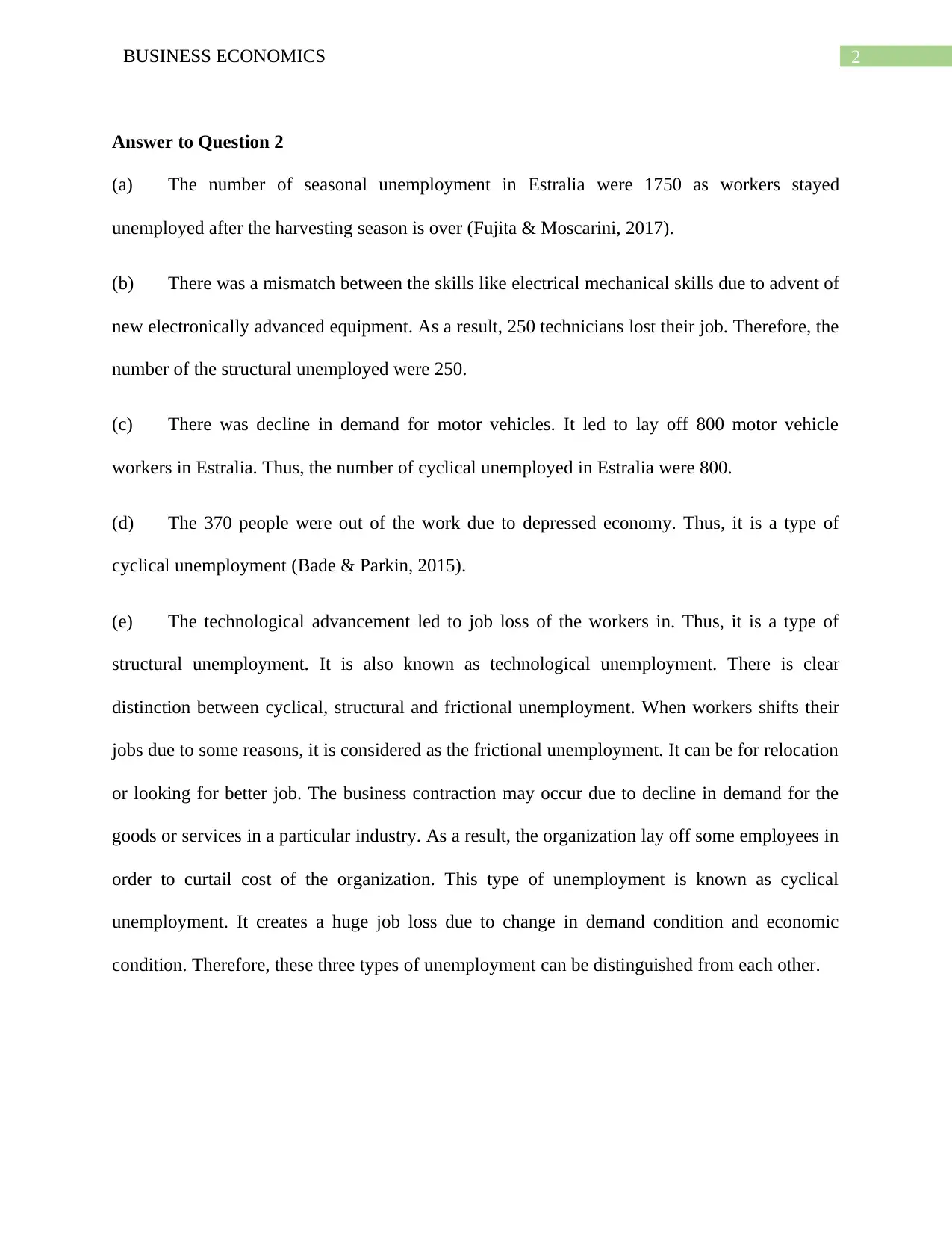
2BUSINESS ECONOMICS
Answer to Question 2
(a) The number of seasonal unemployment in Estralia were 1750 as workers stayed
unemployed after the harvesting season is over (Fujita & Moscarini, 2017).
(b) There was a mismatch between the skills like electrical mechanical skills due to advent of
new electronically advanced equipment. As a result, 250 technicians lost their job. Therefore, the
number of the structural unemployed were 250.
(c) There was decline in demand for motor vehicles. It led to lay off 800 motor vehicle
workers in Estralia. Thus, the number of cyclical unemployed in Estralia were 800.
(d) The 370 people were out of the work due to depressed economy. Thus, it is a type of
cyclical unemployment (Bade & Parkin, 2015).
(e) The technological advancement led to job loss of the workers in. Thus, it is a type of
structural unemployment. It is also known as technological unemployment. There is clear
distinction between cyclical, structural and frictional unemployment. When workers shifts their
jobs due to some reasons, it is considered as the frictional unemployment. It can be for relocation
or looking for better job. The business contraction may occur due to decline in demand for the
goods or services in a particular industry. As a result, the organization lay off some employees in
order to curtail cost of the organization. This type of unemployment is known as cyclical
unemployment. It creates a huge job loss due to change in demand condition and economic
condition. Therefore, these three types of unemployment can be distinguished from each other.
Answer to Question 2
(a) The number of seasonal unemployment in Estralia were 1750 as workers stayed
unemployed after the harvesting season is over (Fujita & Moscarini, 2017).
(b) There was a mismatch between the skills like electrical mechanical skills due to advent of
new electronically advanced equipment. As a result, 250 technicians lost their job. Therefore, the
number of the structural unemployed were 250.
(c) There was decline in demand for motor vehicles. It led to lay off 800 motor vehicle
workers in Estralia. Thus, the number of cyclical unemployed in Estralia were 800.
(d) The 370 people were out of the work due to depressed economy. Thus, it is a type of
cyclical unemployment (Bade & Parkin, 2015).
(e) The technological advancement led to job loss of the workers in. Thus, it is a type of
structural unemployment. It is also known as technological unemployment. There is clear
distinction between cyclical, structural and frictional unemployment. When workers shifts their
jobs due to some reasons, it is considered as the frictional unemployment. It can be for relocation
or looking for better job. The business contraction may occur due to decline in demand for the
goods or services in a particular industry. As a result, the organization lay off some employees in
order to curtail cost of the organization. This type of unemployment is known as cyclical
unemployment. It creates a huge job loss due to change in demand condition and economic
condition. Therefore, these three types of unemployment can be distinguished from each other.
⊘ This is a preview!⊘
Do you want full access?
Subscribe today to unlock all pages.

Trusted by 1+ million students worldwide

3BUSINESS ECONOMICS
Answer to Question 4
Figure 1: The impact of money supply on aggregate demand and investment demand
Source: As created by the author
Figure 1 illustrates the impact of decrease in money supply on aggregate demand and
investment demand. The decrease in money supply leads to rise in interest rate. As a result,
investment demand declines (Agénor & Montiel, 2015). Moreover, with a decrease in investment
demand, aggregated demand in the economy also decreases. Therefore, there is a fall in real GDP
of the economy. There is direct relationship between investment and economic growth. Hence,
fall in investment demand will lead to fall in economic growth. The inflation rate in the economy
decreases due to increase in interest rate. There exists an inverse relationship between the
interest rate and inflation rate. The monetary authority of the country uses money supply in order
to boost the economic growth (Goodwin et al., 2015). The higher interest rate will scale up the
level of unemployment rate. It is a contractionary monetary policy used by the monetary
Answer to Question 4
Figure 1: The impact of money supply on aggregate demand and investment demand
Source: As created by the author
Figure 1 illustrates the impact of decrease in money supply on aggregate demand and
investment demand. The decrease in money supply leads to rise in interest rate. As a result,
investment demand declines (Agénor & Montiel, 2015). Moreover, with a decrease in investment
demand, aggregated demand in the economy also decreases. Therefore, there is a fall in real GDP
of the economy. There is direct relationship between investment and economic growth. Hence,
fall in investment demand will lead to fall in economic growth. The inflation rate in the economy
decreases due to increase in interest rate. There exists an inverse relationship between the
interest rate and inflation rate. The monetary authority of the country uses money supply in order
to boost the economic growth (Goodwin et al., 2015). The higher interest rate will scale up the
level of unemployment rate. It is a contractionary monetary policy used by the monetary
Paraphrase This Document
Need a fresh take? Get an instant paraphrase of this document with our AI Paraphraser
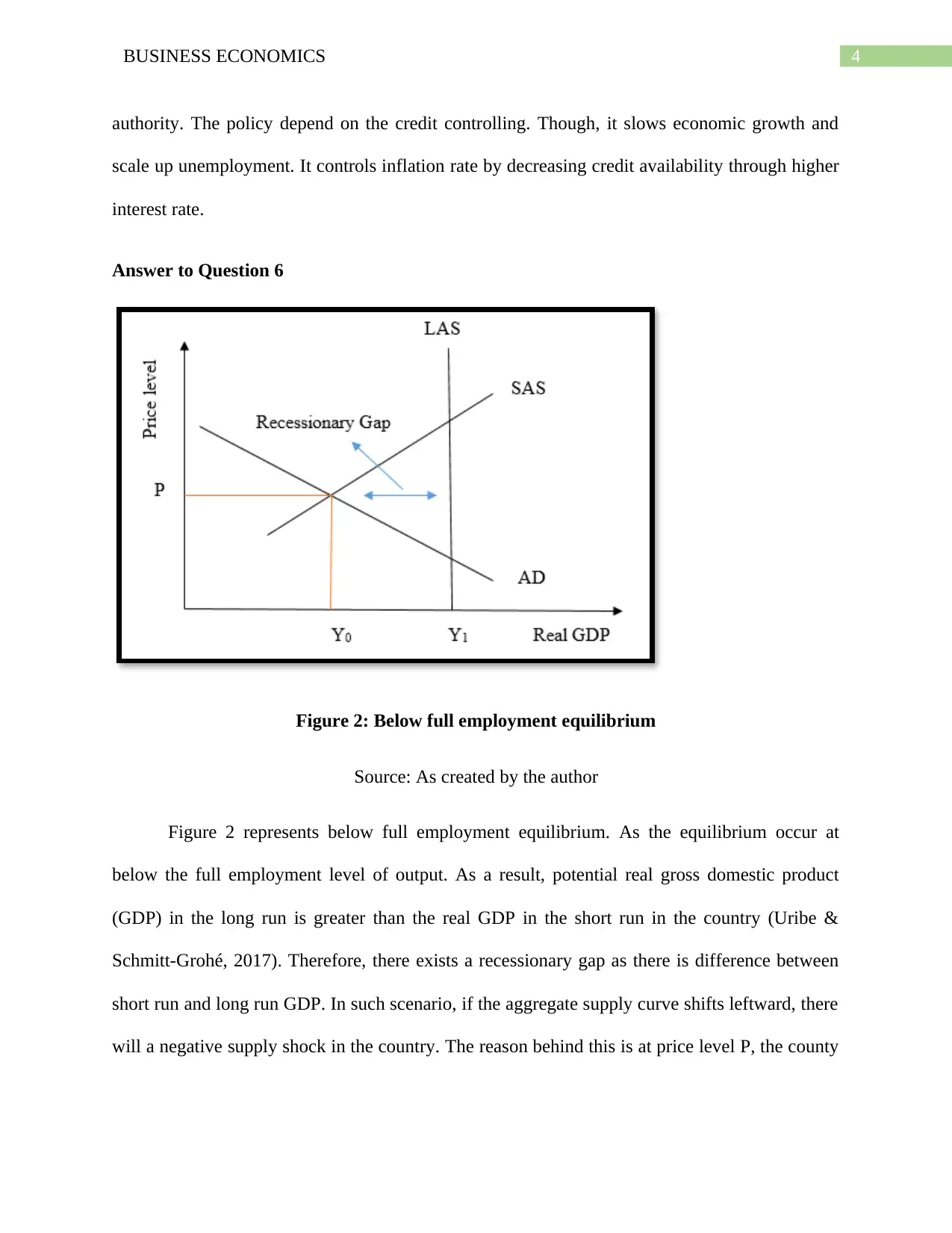
4BUSINESS ECONOMICS
authority. The policy depend on the credit controlling. Though, it slows economic growth and
scale up unemployment. It controls inflation rate by decreasing credit availability through higher
interest rate.
Answer to Question 6
Figure 2: Below full employment equilibrium
Source: As created by the author
Figure 2 represents below full employment equilibrium. As the equilibrium occur at
below the full employment level of output. As a result, potential real gross domestic product
(GDP) in the long run is greater than the real GDP in the short run in the country (Uribe &
Schmitt-Grohé, 2017). Therefore, there exists a recessionary gap as there is difference between
short run and long run GDP. In such scenario, if the aggregate supply curve shifts leftward, there
will a negative supply shock in the country. The reason behind this is at price level P, the county
authority. The policy depend on the credit controlling. Though, it slows economic growth and
scale up unemployment. It controls inflation rate by decreasing credit availability through higher
interest rate.
Answer to Question 6
Figure 2: Below full employment equilibrium
Source: As created by the author
Figure 2 represents below full employment equilibrium. As the equilibrium occur at
below the full employment level of output. As a result, potential real gross domestic product
(GDP) in the long run is greater than the real GDP in the short run in the country (Uribe &
Schmitt-Grohé, 2017). Therefore, there exists a recessionary gap as there is difference between
short run and long run GDP. In such scenario, if the aggregate supply curve shifts leftward, there
will a negative supply shock in the country. The reason behind this is at price level P, the county
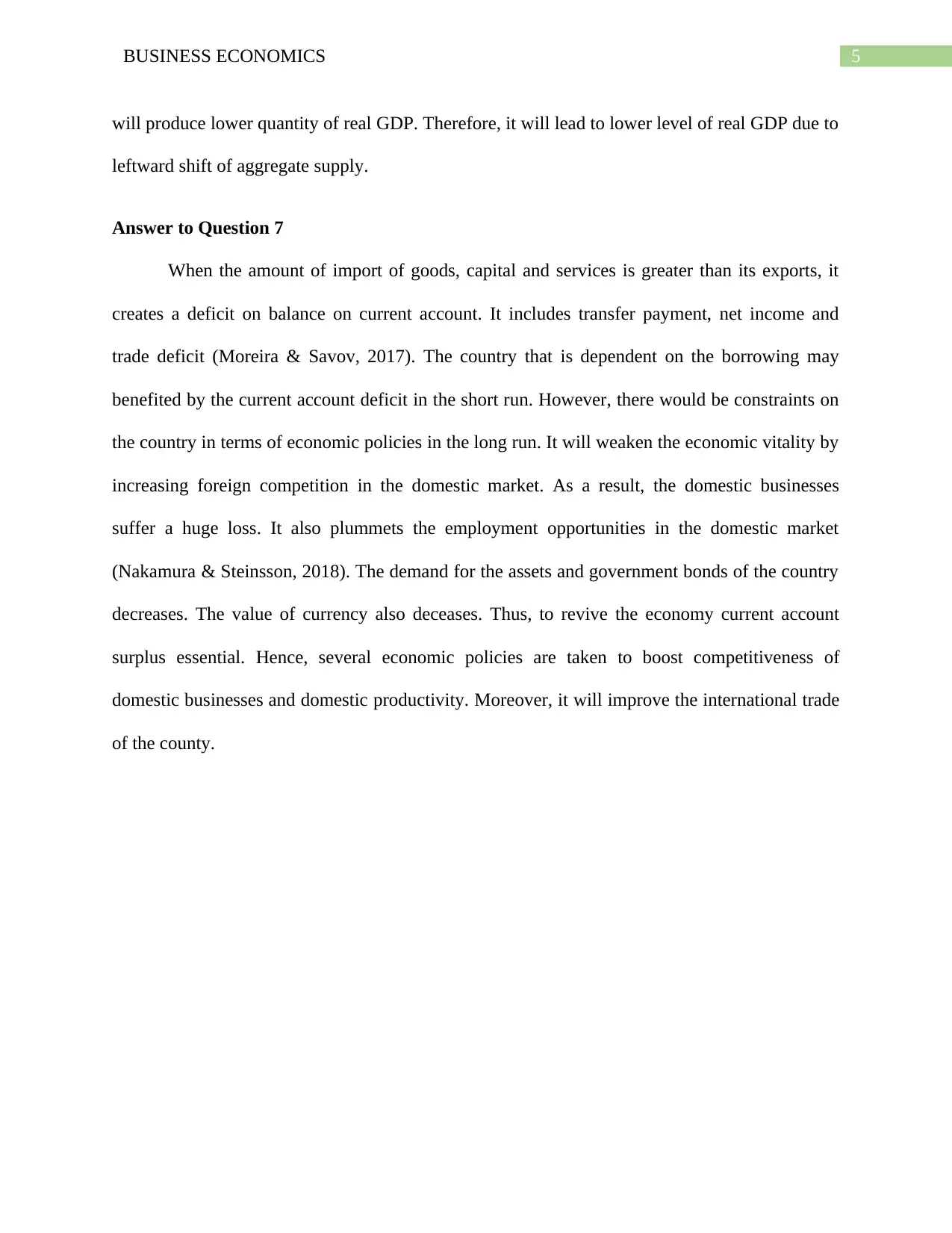
5BUSINESS ECONOMICS
will produce lower quantity of real GDP. Therefore, it will lead to lower level of real GDP due to
leftward shift of aggregate supply.
Answer to Question 7
When the amount of import of goods, capital and services is greater than its exports, it
creates a deficit on balance on current account. It includes transfer payment, net income and
trade deficit (Moreira & Savov, 2017). The country that is dependent on the borrowing may
benefited by the current account deficit in the short run. However, there would be constraints on
the country in terms of economic policies in the long run. It will weaken the economic vitality by
increasing foreign competition in the domestic market. As a result, the domestic businesses
suffer a huge loss. It also plummets the employment opportunities in the domestic market
(Nakamura & Steinsson, 2018). The demand for the assets and government bonds of the country
decreases. The value of currency also deceases. Thus, to revive the economy current account
surplus essential. Hence, several economic policies are taken to boost competitiveness of
domestic businesses and domestic productivity. Moreover, it will improve the international trade
of the county.
will produce lower quantity of real GDP. Therefore, it will lead to lower level of real GDP due to
leftward shift of aggregate supply.
Answer to Question 7
When the amount of import of goods, capital and services is greater than its exports, it
creates a deficit on balance on current account. It includes transfer payment, net income and
trade deficit (Moreira & Savov, 2017). The country that is dependent on the borrowing may
benefited by the current account deficit in the short run. However, there would be constraints on
the country in terms of economic policies in the long run. It will weaken the economic vitality by
increasing foreign competition in the domestic market. As a result, the domestic businesses
suffer a huge loss. It also plummets the employment opportunities in the domestic market
(Nakamura & Steinsson, 2018). The demand for the assets and government bonds of the country
decreases. The value of currency also deceases. Thus, to revive the economy current account
surplus essential. Hence, several economic policies are taken to boost competitiveness of
domestic businesses and domestic productivity. Moreover, it will improve the international trade
of the county.
⊘ This is a preview!⊘
Do you want full access?
Subscribe today to unlock all pages.

Trusted by 1+ million students worldwide
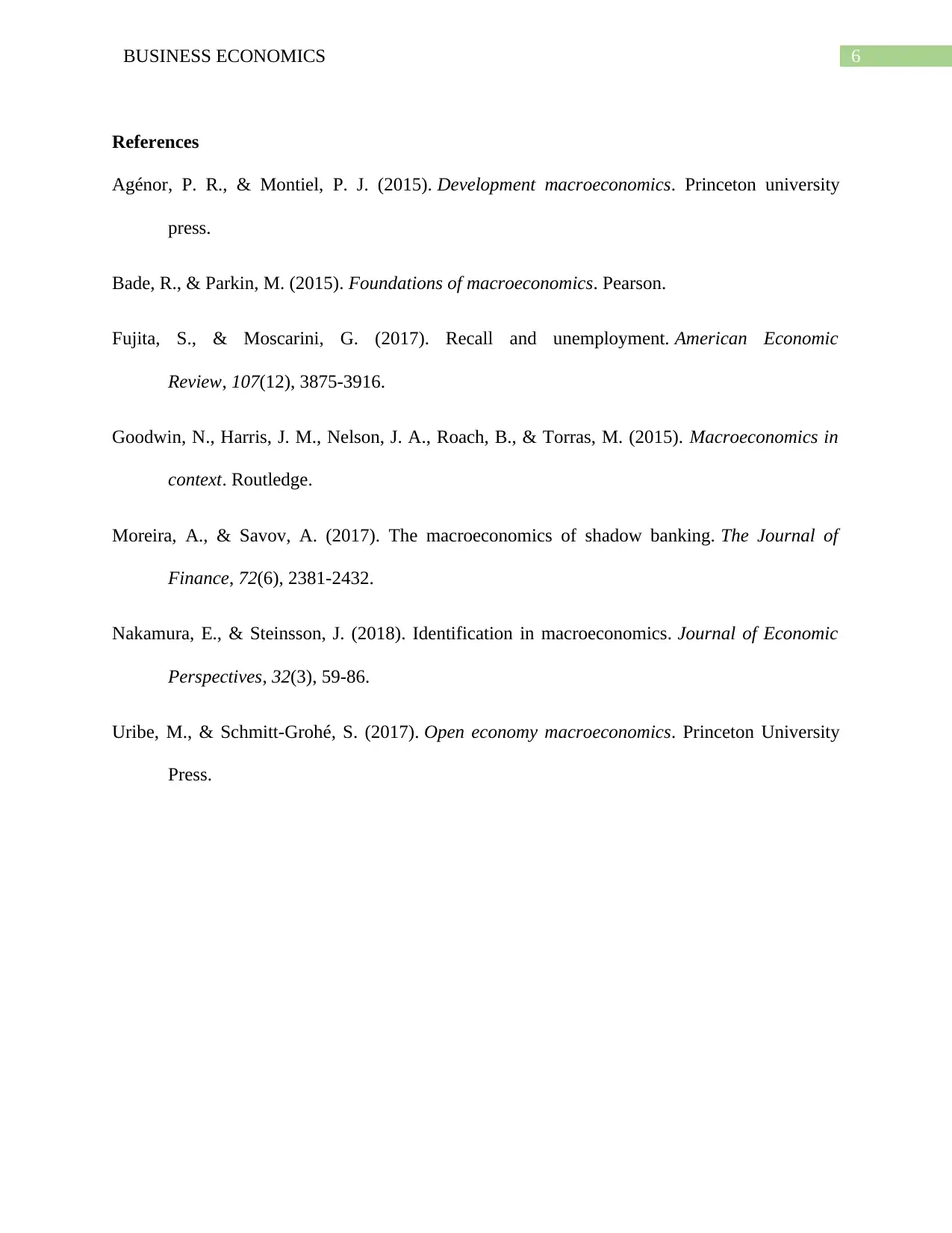
6BUSINESS ECONOMICS
References
Agénor, P. R., & Montiel, P. J. (2015). Development macroeconomics. Princeton university
press.
Bade, R., & Parkin, M. (2015). Foundations of macroeconomics. Pearson.
Fujita, S., & Moscarini, G. (2017). Recall and unemployment. American Economic
Review, 107(12), 3875-3916.
Goodwin, N., Harris, J. M., Nelson, J. A., Roach, B., & Torras, M. (2015). Macroeconomics in
context. Routledge.
Moreira, A., & Savov, A. (2017). The macroeconomics of shadow banking. The Journal of
Finance, 72(6), 2381-2432.
Nakamura, E., & Steinsson, J. (2018). Identification in macroeconomics. Journal of Economic
Perspectives, 32(3), 59-86.
Uribe, M., & Schmitt-Grohé, S. (2017). Open economy macroeconomics. Princeton University
Press.
References
Agénor, P. R., & Montiel, P. J. (2015). Development macroeconomics. Princeton university
press.
Bade, R., & Parkin, M. (2015). Foundations of macroeconomics. Pearson.
Fujita, S., & Moscarini, G. (2017). Recall and unemployment. American Economic
Review, 107(12), 3875-3916.
Goodwin, N., Harris, J. M., Nelson, J. A., Roach, B., & Torras, M. (2015). Macroeconomics in
context. Routledge.
Moreira, A., & Savov, A. (2017). The macroeconomics of shadow banking. The Journal of
Finance, 72(6), 2381-2432.
Nakamura, E., & Steinsson, J. (2018). Identification in macroeconomics. Journal of Economic
Perspectives, 32(3), 59-86.
Uribe, M., & Schmitt-Grohé, S. (2017). Open economy macroeconomics. Princeton University
Press.
1 out of 7
Related Documents
Your All-in-One AI-Powered Toolkit for Academic Success.
+13062052269
info@desklib.com
Available 24*7 on WhatsApp / Email
![[object Object]](/_next/static/media/star-bottom.7253800d.svg)
Unlock your academic potential
Copyright © 2020–2025 A2Z Services. All Rights Reserved. Developed and managed by ZUCOL.





